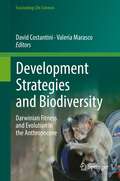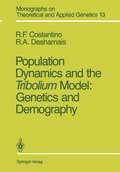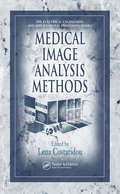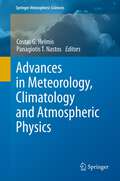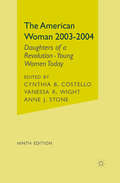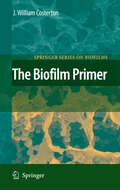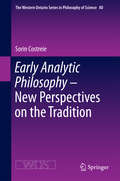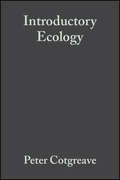- Table View
- List View
Development Strategies and Biodiversity: Darwinian Fitness and Evolution in the Anthropocene (Fascinating Life Sciences)
by David Costantini Valeria MarascoDevelopment is a complex and highly dynamic process involving the cross talk among genes, maternal effects and environmental circumstances. Widespread evidence from plant to animal species show that variation in developmental conditions can modulate life history trajectories and influence key traits, such as growth, reproduction, and senescence. These effects are not limited to a single generation but can also be passed on future generations. This book aims to bring together studies of early life effects from the fields of evolutionary biology, global change biology, and biomedicine to synthesise and improve current knowledge of the mechanisms involved, and how variation in early life conditions translates into Darwinian fitness outcomes. Relying on examples of organisms’ responses to the ongoing and future environmental challenges of the Anthropocene, this book takes a novel approach to address the adaptive meaning of early life effects. The book has a broad scientific approach, targeting eco-evolutionary biologists, behavioural biologists, eco-physiologists, eco-toxicologists, as well as epidemiologists and biomedical scientists.
Population Dynamics and the Tribolium Model: Genetics and Demography (Monographs on Theoretical and Applied Genetics #13)
by Robert F. Costantino Robert A. DesharnaisThe study of populations is becoming increasingly focused on dynamics. We believe there are two reasons for this trend. The ftrst is the impactof nonlinear dynamics with its exciting ideas and colorful language: bifurcations, domains of attraction, chaos, fractals, strange attractors. Complexity, which is so very much a part of biology, now seems to be also a part of mathematics. A second trend is the accessibility of the new concepts. Thebarriers tocommunicationbetween theoristandexperimentalistseemless impenetrable. The active participationofthe experimentalist means that the theory will obtain substance. Our role is the application of the theory of dynamics to the analysis ofbiological populations. We began our work early in 1979 by writing an ordinary differential equation for the rateofchange in adult numbers which was based on an equilibrium model proposed adecadeearlier. Duringthenextfewmonths weftlledournotebookswithstraightforward deductions from the model and its associated biological implications. Slowly, some of the biological observations were explained and papers followed on a variety of topics: genetic and demographic stability, stationary probability distributions for population size,population growth asabirth-deathprocess, natural selectionanddensity-dependent population growth, genetic disequilibrium, and the stationary stochastic dynamics of adult numbers.
An Introduction to Ecological Economics
by Robert Costanza John H. Cumberland Herman Daly Robert Goodland Richard B. Norgaard Ida Kubiszewski Carol FrancoFrom Empty-World Economics to Full-World EconomicsEcological economics explores new ways of thinking about how we manage our lives and our planet to achieve a sustainable, equitable, and prosperous future. Ecological economics extends and integrates the study and management of both "nature's household" and "humankind's household"-An Introduction to
Landscape Simulation Modeling: A Spatially Explicit, Dynamic Approach (Modeling Dynamic Systems)
by Robert Costanza Alexey VoinovThe world consists of many complex systems, ranging from our own bodies to ecosystems to economic systems. Despite their diversity, complex systems have many structural and functional features in common that can be effectively si- lated using powerful, user-friendly software. As a result, virtually anyone can - plore the nature of complex systems and their dynamical behavior under a range of assumptions and conditions. This ability to model dynamic systems is already having a powerful influence on teaching and studying complexity. The books in this series will promote this revolution in “systems thinking” by integrating computational skills of numeracy and techniques of dynamic mod- ing into a variety of disciplines. The unifying theme across the series will be the power and simplicity of the model-building process, and all books are designed to engage the reader in developing their own models for exploration of the dyn- ics of systems that are of interest to them. Modeling Dynamic Systems does not endorse any particular modeling paradigm or software. Rather, the volumes in the series will emphasize simplicity of lea- ing, expressive power, and the speed of execution as priorities that will facilitate deeper system understanding.
Physiology, E-Book: With Student Consult Online Access (Board Review Ser.)
by Linda S. CostanzoPhysiology is a comprehensive presentation of core physiologic concepts with a focus on mechanisms. Renowned physiology instructor Linda S. Costanzo covers important concepts in the field, both at the organ system and cellular levels. Easy to read and user-friendly, the revised fourth edition stresses essential and relevant content with absolute clarity and includes concise step-by-step explanations complemented by numerous tables and abundant illustrations. It provides information on the underlying principles of cellular physiology, the autonomic nervous system, and neurophysiology, as well as the cardiovascular, respiratory, renal, acid-base, gastrointestinal, endocrine, and reproductive organ systems. This book is ideal as both a textbook and as a review guide for the boards.Provides step-by-step explanations and easy-to-follow diagrams clearly depicting physiologic principles. Integrates equations and sample problems throughout the text. Presents chapter summaries for quick overviews of important points. Contains boxed Clinical Physiology Cases to provide you with more clinical examples and a more thorough understanding of application. Provides questions at the end of each chapter for an extensive review of the material and to reinforce your understanding and retention. Offers a full-color design and all full-color illustrations throughout. Features increased coverage of pathophysiology in the neurophysiology, gastrointestinal, renal, acid-base, and endocrine chapters to emphasize this important component of the USMLE exam. Incorporates further practice in solving physiology equations through the inclusion of additional problem-solving questions throughout the text.
Ultrafast Dynamics of Phospholipid-Water Interfaces: Studied by Nonlinear Time-Resolved Vibrational Spectroscopy (Springer Theses)
by René CostardThis thesis presents a highly innovative study of the ultrafast structural and vibrational dynamics of hydrated phospholipids, the basic constituents of cell membranes. As a novel approach to the water-phospholipid interface, the author studies phosphate vibrations using the most advanced methods of nonlinear vibrational spectroscopy, including femtosecond two-dimensional infrared spectroscopy. He shows for the first time that the structure of interfacial water undergoes very limited fluctuations on a 300 fs time scale and that the lifetimes of hydrogen bonds with the phospholipid are typically longer than 10 ps. Such properties originate from the steric hindrance of water fluctuations at the interface and the orienting action of strong electric fields from the phospholipid head group dipoles. In an extensive series of additional experiments, the vibrational lifetimes of the different vibrations and the processes of energy dissipation are elucidated in detail.
Medical Image Analysis Methods
by Lena CostaridouTo successfully detect and diagnose disease, it is vital for medical diagnosticians to properly apply the latest medical imaging technologies. It is a worrisome reality that due to either the nature or volume of some of the images provided, early or obscured signs of disease can go undetected or be misdiagnosed. To combat these inaccuracies, diagno
Medical Image Analysis Methods (Electrical Engineering And Applied Signal Processing Ser.)
by Lena CostaridouTo successfully detect and diagnose disease, it is vital for medical diagnosticians to properly apply the latest medical imaging technologies. It is a worrisome reality that due to either the nature or volume of some of the images provided, early or obscured signs of disease can go undetected or be misdiagnosed. To combat these inaccuracies, diagno
Advances in Meteorology, Climatology and Atmospheric Physics (Springer Atmospheric Sciences)
by Costas G. Helmis and Panagiotis T. NastosThis book essentially comprises the proceedings of the 11th International Conference of Meteorology, Climatology and Atmospheric Physics (COMECAP 2012) that is held in Athens from 30 May to 1 June 2012. The Conference addresses researchers, professionals and students interested in the following topics: Agricultural Meteorology and Climatology, Air Quality, Applied Meteorology and Climatology, Applications of Meteorology in the Energy Sector, Atmospheric Physics and Chemistry, Atmospheric Radiation, Atmospheric Boundary Layer, Biometeorology and Bioclimatology, Climate Dynamics, Climatic Changes, Cloud Physics, Dynamic and Synoptic Μeteorology, Extreme Events, Hydrology and Hydrometeorology, Mesoscale Meteorology, Micrometeorology/Urban Microclimate, Remote Sensing/ Satellite Meteorology and Climatology, Weather Analysis and Forecasting. The book includes all papers that have been accepted for presentation at the conference.
The American Woman, 2003-2004: Daughters of a Revolution: Young Women Today
by C. Costello V. Wight A. StoneThe American Woman is an established, widely respected series on the status of American women, prepared biannually by the Women's Research and Education Institute (WREI). The purpose of the series is to provide an important, convenient, and timely source of accessible and 'user-friendly' information on American women to the media, students and scholars, advocates for women's equity, and policymakers. Each edition of the series focuses on a particular theme, and the ninth edition will address young women between the ages of 25 and 35. Contributors - all experts in the field of women's issues - will explore the opportunities and challenges confronting the young women who are the daughters of the baby boomer generation. A focus on young women will bring into sharp relief how much has changed in the decades since 1960 and how much remains the same. A statistical portrait will accompany the volume, including user-friendly charts and graphs that provide readers with the hard numbers that underlie the trends shaping women's experiences.
Theory of Wire Rope (Mechanical Engineering Series)
by George A. CostelloMechanical engineering, an engineering discipline borne of the needs of the industrial revolution, is once again asked to do its substantial share in the call for industrial renewal. The general call is urgent as we face profound issues of productivity and competitiveness that require engineering solutions, among others. The Mechanical Engineering Series is a new series, featuring graduate texts and research monographs, intended to address the need for information in contemporary areas of mechanical engineering. The series is conceived as a comprehensive one that will cover a broad range of concentrations important to mechanical engineering graduate education and research. We are fortunate to have a distinguished roster of consulting editors, each an expert in one of the areas of concentration. The names of the consulting editors are listed on the first page of the volume. The areas of concentration are applied mechanics, biomechanics, computational mechanics, dynamic systems and control, energetics, mechanics of materials, processing, thermal science, and tribology. Professor Leckie, the consulting editor for applied mechanics, and I are pleased to present the third volume of the series: Theory of Wire Rope by Professor Costello. The selection of this volume underscores again the interest of the Mechanical Engineering Series to provide our readers with topical monographs as well as graduate texts.
Sustainable Luxury and Craftsmanship (Environmental Footprints and Eco-design of Products and Processes)
by Ivan Coste-Manière Miguel Ángel GardettiThis book explores the intricate relationship between luxury and craftsmanship, using brand-based case studies and consumer behavior to do so. In addition to revealing how the artification of luxury affects consumer behavior with branding and traditions, it discusses how sustainable luxury could not only offer a vehicle for more respect for the environment and social development, but could also be a metaphor for the cultures, art traditions, and innovations of various nationalities, continuing the legacy of local craftsmanship.
Discovery Pack: Crystals and Gemstones (Discovery Pack #2)
by Patience Coster Tracey KellyHave you ever wondered where precious, glittering gemstones come from, how crystals form, or where you can see some of the biggest diamonds on Earth? Inside this book you'll discover tons of rock-solid facts and high-carat images alongside cutting-edge science. You will find out everything you need to know about the sparkling, captivating world of gemstones and crystals! Perfect for kids aged 7+. ABOUT THE SERIES: Discovery Pack is a science reference series for kids, focusing on a variety of exciting topics from the human body to space exploration. Vibrantly illustrated in full-colour these books make science accessible and engaging.
The Biofilm Primer (Springer Series on Biofilms #1)
by J. William CostertonThis book details the widely accepted hypothesis that the majority of bacteria in virtually all ecosystems grow in matrix-enclosed biofilms. The author, who first proposed this biofilm hypothesis, uses direct evidence from microscopy and from molecular techniques, arguing cogently for moving beyond conventional culture methods that dominated microbiology in the last century. Bacteria grow predominantly in biofilms in natural, engineered, and pathogenic ecosystems; this book provides a solid basis for the understanding of bacterial processes in environmental, industrial, agricultural, dental and medical microbiology. Using a unique "ecological" perspective, the author explores the commensal and pathogenic colonization of human organ systems.
Early Analytic Philosophy - New Perspectives on the Tradition: New Perspectives On The Tradition (The Western Ontario Series in Philosophy of Science #80)
by Sorin CostreieThis volume discusses some crucial ideas of the founders of the analytic philosophy: Gottlob Frege, Bertrand Russell and Ludwig Wittgenstein, or the ‘golden trio’. The book shows how these ‘old’ ideas are still present and influential in the current philosophical debates and to what extent these debates echo the original ideas. The collection aim is twofold: to better understand these fruitful ideas by placing them in the original setting, and to systematically examine these ideas in the context of the current debates animating philosophical discussions today. Divided into five sections, the book first sets the stage and offers a general introduction to the background influences, as well as delimitations of the initial foundational positions. This first section contains two papers dedicated to the discussion of realism and the status of science at that time, followed by two papers that tackle the epistemic status of logical laws. The next three sections constitute the core of the volume, each being dedicated to the most important figures in the early analytic tradition: Frege, Russell, and Wittgenstein. The last section gathers several essays that discuss either the relation between two or more analytic thinkers, or various important concepts such as ‘predicativism’ and ‘arbitrary function’, or the principles of abstraction and non-contradiction.
Phosgenations: A Handbook
by Livius Cotarca Heiner EckertIn this manual, the authors compare the range of applications for phosgene with that of the alternative compounds, dealing in detail with the possible uses of diphosgene, triphosgene, carbon dioxide, organic carbonates, oxalylchloride and many other alternative materials used in synthesis. However, they clearly point out those cases where phosgene continues to have the advantage. The result is a mine of information for synthetic chemists working in industry and academia faced with the question of where the toxic phosgene can be replaced by an unproblematic compound - including the safety phosgenation.
Controlling Chemical Hazards: Fundamentals of the management of toxic chemicals
by R.P. Cote P.G. WellsThis book presents environmental protection managers and advanced students in environmental studies programs with an overview of the principles, facts, multidisciplinary approaches, and some of the complex ities of the management of toxic substances. The text explores critical issues facing managers responsible for prevent ing and controlling problems associated with the manufacture,. transport, storage, use and disposal of chemicals. It does this from two perspectives. The first is a disciplinary perspective, that is environmental chemistry, of toxicology, engineering, economics, sociology and political science, all which playa role in implementing comprehensive programs to manage chemicals. The second perspective is from the view of industry, govern ment, academia and non-government organizations. For example, Chapter 5 is authored by technical managers of a major chemical company, Chap ters 6 and 12 by government scientists and managers respectively, and Chapter 10 by a respected member of the environmental lobby. An appreciation of these perspectives is very important for developing and running effective chemical management programs.
Biomass Utilization (Nato Science Series A: #67)
by Wilfred CoteThis proceedings volume represents the culmination of nearly three years of planning, organizing and carrying out of a NATO Ad vanced Study Institute on Biomass Utilization. The effort was initi ated by Dr. Harry Sobel, then Editor of Biosources Digest, and a steering committee representing the many disciplines that this field brings together. . When the fiscal and logistical details of the original plan could not be worked out, the idea was temporarily suspended. In the spring of 1982, the Renewable Materials Institute of the State University of New York at the College of Environmental Science and Forestry in Syracuse, New York revived the plan. A number of modifications had to be made, including the venue which was changed from the U.S.A. to Portugal. Additional funding beyond the basic support provided by the Scientific Affairs Division of NATO had to be obtained. Ul timately there were supplementary grants from the Foundation for Microbiology and the Anne S. Richardson Fund to assist student participants. The New York State College of Forestry Foundation, Inc. provided major support through the Renewable Ma terials Institute. The ASI was held in Alcabideche, Portugal from September 26 to October 9, 1982. Eighty participants including fifteen principal lecturers were assembled at the Hotel Sintra Estoril for the program that was organized as a comprehensive course on biomass utilization. The main lectures were supplemented by relevant short papers offered by the participants.
Der Siemens-Martin-Ofen: Die Grundsätze des Herdstahlofen-Betriebes
by Ernst CotelDieser Buchtitel ist Teil des Digitalisierungsprojekts Springer Book Archives mit Publikationen, die seit den Anfängen des Verlags von 1842 erschienen sind. Der Verlag stellt mit diesem Archiv Quellen für die historische wie auch die disziplingeschichtliche Forschung zur Verfügung, die jeweils im historischen Kontext betrachtet werden müssen. Dieser Titel erschien in der Zeit vor 1945 und wird daher in seiner zeittypischen politisch-ideologischen Ausrichtung vom Verlag nicht beworben.
Proceedings of the Galactic Center Workshop 2002, Astronomische Nachrichten Supplementary Issue 1/2003: The Central 300 Parsecs of the Milky Way
by Angela Cotera Sera Markoff Thomas R. Geballe Heino FalckeOur knowledge of the environment of the nucleus of our galaxy has been greatly enhanced, by more extensive and sensitive observations at radio and infrared wavelengths, the advent of high resolution x-ray imaging and spectroscopy, and considerable theoretical activity to understand the nucleus and its components, and their activity. The Galactic Center Workshop 2002 was organized to review recent research on the galactic center, including the latest state-of-the-art observations and important theoretical developments. The workshop covered phenomena on scales ranging from the central several hundred parsecs to the central parsec and within. Each topic was approached from both multi-wavelength observational and theoretical perspectives.
Introductory Ecology
by Peter Cotgreave Irwin ForsethIn this age of increasing human domination of the Earth's biological and physical resources, a basic understanding of ecology is more important than ever. Students need a textbook that introduces them to the basic principles of ecological science, one that is relevant to today's world, and one that does not overwhelm them with detail and jargon. Peter Cotgreave and Irwin Forseth have designed this book to meet the needs of these students, by providing a basic synthesis of how individual organisms interact with their physical environment, and with each other, to generate the complex ecosystems we see around us. The unifying theme of the book is biodiversity-its patterns, causes, and the growing worldwide threats to it. Basic ecological principles are illustrated using clearly described examples from the current ecological literature. This approach makes the book valuable to all students studying ecology. Examples have been chosen carefully to represent as wide a range of ecosystems (terrestrial and aquatic, northern and southern hemisphere) and life forms (animal, plant and microbe) as possible. Particular attention is paid to consequences of global change on organisms, populations, ecological communities and ecosystems. The end result is a text that presents a readable and persuasive picture of how the Earth's natural systems function, and how that functioning may change over the coming century. Features include: · strong coverage of applied and evolutionary ecology · applications of ecology to the real world · a question-orientated approach · the only comprehensive treatment of ecology written for the introductory student · an emphasis on definitions of key words and phrases · an integration of experimental, observational and theoretical material · examples drawn from all over the world and a wide variety of organisms · a logical structure, building from the response of individual organisms to physical factors, through population growth and population interactions, to community structure and ecosystem function · suggested further reading lists for each chapter · boxes to explain key concepts in more depth · dedicated textsite featuring additional information and teaching aids www.blackwellpublishing.com/cotgreave Peter Cotgreave is an animal ecologist who has worked for the University of Oxford and the Zoological Society of London. His research interests centre on abundance and rarity within animal communities. Irwin Forseth is a plant physiological ecologist who has taught introductory ecology and plant ecology at the University of Maryland since 1982. His research focuses on plant responses to the environment. The authors have studied organisms as diverse as green plants, insects and mammals in habitats from deserts to tropical rainforests. They have worked in ecological research and education in Africa, Asia, North and South America, Europe and the Caribbean.
Environmental Radon (Environmental Science Research #35)
by C. Richard Cothern James E. Smith Jr.This volume is intended for the professional who is a newcomer to the area of environmental radon. It marks the first time that chapters on these subjects have been brought together in a single volume, and it is arranged so that anyone with some basic university-level chemistry and physics can develop a clear understanding of the different aspects involved. The volume is intended to serve as a supplementary textbook in public health, environmental, and health physics courses. It also can be used by the professional to get "up to speed" in this rapidly evolving field. The chapters are not necessarily a discussion of the latest research in this fast-moving field, but are intended to bring the reader to a level at which he can easily understand the current literature. At the back of this volume the reader will find the references for the individual chapters, a general list of reading materials, a glossary, an appendix describing the equations for radioactive decay for a series of progeny, a table of often used conversion factors, and the addresses and brief biographies of the authors and editors. Both historical and SI (International System) units are used throughout the book to provide information for the widest range of readers. Thanks go to Tom Hess for the idea for this volume and to Jessica Barron for help in editing.
The Transformation of Italian Armed Forces in Comparative Perspective: Adapt, Improvise, Overcome? (Military Strategy and Operational Art)
by Fabrizio Coticchia Francesco N. MoroEuropean armed forces have undergone deep changes in the past two decades. Given the breadth of the debate and the size of transformations that took place, it is somewhat surprising that relatively few academic studies have directly dealt with changes in force structure of European militaries, and the Italian armed forces in particular. The focus of this book is the organizational dimension of the restructuring of armed forces through 3 different lenses: doctrine and strategic framework, budget and resource allocation, and force structure and deployment. The key issues addressed relate to how these factors interact in shaping transformation. Of particular interest is the theme of learning, which is how armed forces endogenize change in the short and long run. This study provides valuable insights into the extent to which armed forces manage to adapt to the emerging strategic and operational challenges they have to face and to illustrate the weight of institutional legacies, resource constraints and inter-organizational learning in shaping transformation. Focusing on the Italian case in comparative perspective and based on a large variety of military operations from airstrikes to peacekeeping and counterinsurgency, the book provides an innovative viewpoint on military transformation and significantly contributes to our understanding of contemporary security that is deeply shaped by the lessons learnt in Afghanistan, Lebanon, Iraq and Libya.
The Transformation of Italian Armed Forces in Comparative Perspective: Adapt, Improvise, Overcome? (Military Strategy and Operational Art)
by Fabrizio Coticchia Francesco N. MoroEuropean armed forces have undergone deep changes in the past two decades. Given the breadth of the debate and the size of transformations that took place, it is somewhat surprising that relatively few academic studies have directly dealt with changes in force structure of European militaries, and the Italian armed forces in particular. The focus of this book is the organizational dimension of the restructuring of armed forces through 3 different lenses: doctrine and strategic framework, budget and resource allocation, and force structure and deployment. The key issues addressed relate to how these factors interact in shaping transformation. Of particular interest is the theme of learning, which is how armed forces endogenize change in the short and long run. This study provides valuable insights into the extent to which armed forces manage to adapt to the emerging strategic and operational challenges they have to face and to illustrate the weight of institutional legacies, resource constraints and inter-organizational learning in shaping transformation. Focusing on the Italian case in comparative perspective and based on a large variety of military operations from airstrikes to peacekeeping and counterinsurgency, the book provides an innovative viewpoint on military transformation and significantly contributes to our understanding of contemporary security that is deeply shaped by the lessons learnt in Afghanistan, Lebanon, Iraq and Libya.
Behavioral Neuroscience: An Introduction
by Carl W. Cotman James L McGaughBehavioral Neuroscience: An Introduction provides a basic understanding of what is known about the means by which neurons communicate and about the nervous system which interprets, integrates, and transmits signals into meaningful and appropriate behaviors. The book starts with an overview of the nervous system. The text then describes the general operation and organization of the nervous system; and some of the major types of neurons in the context of their systems. The basic characteristics of neurons and how they communicate; the processes and the basic integrative properties of defined groups of neurons; and complex learning and memory are also considered. The book further tackles the auditory, somesthetic, olfactory, gustatory, visual, and motor systems; the functions of the autonomic nervous system and the neuroendocrine system; and the neural basis of two types of motivated behavior, drinking and feeding. The text also encompasses sleep and activity rhythms; the development of the neural circuitry and its plasticity throughout life; and the development of behavior. Behavioral disorders and the aspects of the human nervous system which make man unique among all living creatures are also looked into. Behavioral psychologists, behavioral neuroscientists, and psychobiologists will find the book invaluable.
